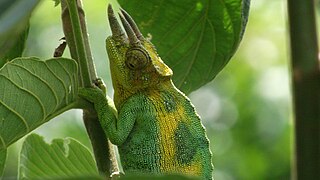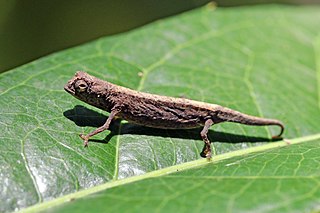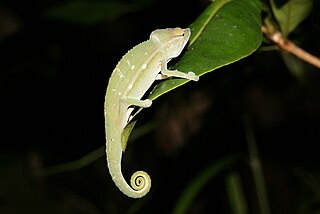
Chameleons or chamaeleons are a distinctive and highly specialized clade of Old World lizards with 202 species described as of June 2015. These species come in a range of colors, and many species have the ability to change color.

Bradypodion is one of six genera of chameleons within the "true" or "typical" chameleons. They are native to southern Africa, and are sometimes collectively called South African dwarf chameleons. Some other small chameleons from eastern and central Africa are occasionally placed herein, but this is probably in error and not followed here. See also Systematics below and Kinyongia and Nadzikambia.

Calumma is a genus of chameleons endemic and restricted to Madagascar. The species formerly named Calumma tigris was transferred to the genus Archaius by Townsend et al. When they found that it is more closely related to Rieppeleon than to Calumma. The oldest fossil of the genus is known from the Early Miocene of Kenya, showing that the genus originated in Africa.

Chamaeleo is a genus of chameleons in the family Chamaeleonidae. Most species of the genus Chamaeleo are found in sub-Saharan Africa, but a few species are also present in northern Africa, southern Europe, and southern Asia east to India and Sri Lanka.

Brookesia is a genus of chameleons, endemic to Madagascar, that range from small to very small in size, and are known collectively as leaf chameleons. Brookesia includes species considered to be the world's smallest chameleons, and are also among the smallest reptiles. Members of the genus Brookesia are largely brown and most are essentially terrestrial.

Rhampholeon is a genus of small chameleons, commonly known as pygmy chameleons or African leaf chameleons, found in central East Africa. They are found in forests, woodlands, thickets, and savanna, and most species are restricted to highlands. They are brown, grey, or green, and typically seen at low levels in bushes, or on the ground among grasses or leaf litter.

Albert Karl Ludwig Gotthilf Günther FRS, also Albert Charles Lewis Gotthilf Günther, was a German-born British zoologist, ichthyologist, and herpetologist. Günther is ranked the second-most productive reptile taxonomist with more than 340 reptile species described.

The spectral pygmy chameleon, western pygmy chameleon, or Cameroon stumptail chameleon is one of the so-called "dwarf" or "leaf" chameleons, from mainland Africa.

The Indian chameleon is a species of chameleon found in Sri Lanka, India, and other parts of South Asia. Like other chameleons, this species has a long tongue, feet that are shaped into bifid claspers, a prehensile tail, independent eye movement, and the ability to change skin colour. They move slowly with a bobbing or swaying movement and are usually arboreal. Strangely, they do not choose the background colour and may not even be able to perceive colour differences. They are usually in shades of green or brown or with bands. They can change colour rapidly and the primary purpose of colour change is for communication with other chameleons and for controlling body temperature by changing to dark colours to absorb heat.

Rieppeleon is a genus of small, typically brown chameleons found in forests and savannas in central East Africa. They are found at low levels in bushes, or on the ground among grass or leaf litter.

Trioceros johnstoni, known commonly as Johnston's chameleon, Johnston's three-horned chameleon, or the Ruwenzori three-horned chameleon, is an endemic chameleon of the Albertine Rift in Central Africa.

Brookesia minima, (common names of which include the dwarf chameleon, the Madagascan dwarf chameleon, the minute leaf chameleon, and the Nosy Be pygmy leaf chameleon, is a diminutive chameleon that was regarded as the smallest lizard of the Chamaeleonidae until a smaller species, B. micra, was described in 2012.

Marshall's pygmy chameleon, also called Marshall's leaf chameleon, Marshall's dwarf chameleon, or Marshall's stumptail chameleon, is a species of chameleon found in the forests of Zimbabwe and Mozambique in Africa. It grows from 3.5 to 7.5 cm and feeds on insects. When standing still, it resembles a leaf on a branch.

Chamaeleoninae is the nominotypical subfamily of chameleons. The Family Chamaeleonidae was divided into two subfamilies, Brookesiinae and Chamaeleoninae, by Klaver and Böhme in 1986. Since its erection in 1986, however, the validity of this subfamily designation has been the subject of much debate, although most phylogenetic studies support the notion that the pygmy chameleons of the subfamily Brookesiinae are not a monophyletic group. While some authorities have previously preferred to use the subfamilial classification on the basis of the absence of evidence principal, these authorities later abandoned this subfamilial division, no longer recognizing any subfamilies with the family Chamaeleonidae. In 2015, however, Glaw reworked the subfamilial division by placing only the genera Brookesia and Palleon within the Brookesiinae subfamily, with all other genera being placed in Chamaeleoninae.

Rieppeleon kerstenii is species of chameleon, a lizard in the family Chamaeleonidae. The species is endemic to East Africa.
Kinyongia adolfifriderici is a species of chameleon, a lizard in the family Chamaeleonidae. The species is native to central Africa and east Africa.

Kinyongia boehmei is species of chameleons, a lizard in the family Chamaeleonidae. The IUCN Red List gives two alternative English common names for this species: Taita blade-horned chameleon and Böhme's two-horned chameleon. The species is endemic to Kenya.

Kinyongia vosseleri, also known commonly as the Usambara two-horned chameleon and Vosseler's blade-horned chameleon, is an endangered species of lizard in the family Chamaeleonidae. The species is endemic to Tanzania.
Rhampholeon bruessoworum, the Mount Inago pygmy chameleon, is a small species of chameleon endemic to Mozambique. It was described in 2014. It has been found in small patches of wet forest at the base of the Mount Inago granitic inselberg. It is only known from that locality. The wet forests it inhabits are mid-altitude afrotemperate, 1,430–1,480 m (4,690–4,860 ft), with a canopy height primarily 20–30 m (66–98 ft) tall. The lizard occurs in highly fragmented and threatened portions. Its habitat quality is degrading, with pressures from logging for agricultural land and commercial logging operations. Because of its reduced and threatened habitat, it is considered Critically Endangered on the IUCN Red List. Males grow to 56 mm (2.2 in) and females to 62 mm (2.4 in).
Rhampholeon chapmanorum, Chapmans's pygmy chameleon, is a species of terrestrial pygmy chameleon in the family Chamaeleonidae, endemic to forest fragments in the Natundu Hills, Malawi. It was described by Tilbury, in 1992 from a patch of lowland seasonal rainforest in the Matandwe Forest Reserve.
















